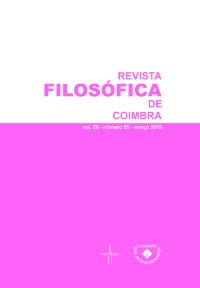Please use this identifier to cite or link to this item:
https://hdl.handle.net/10316.2/46495| Title: | Triumph of the ΠΑΝΤΟΠΟΡΟΣ?: the image of the self‑invented and self‑inventing δεινόν in Antigone’s first stasimon | Authors: | Carvalho, M. Jorge de | Keywords: | Sophocle,;Antigone,;premier stasimon;“πολλὰ τὰ δεινά”;παντοπόρος;δεινόν;εὕρεσις;τέχνη;être humain;anthropologie philosophique,;pensée grecque ancienne;Kulturentstehungslehre;Sophocles;Antigone;First Stasimon;Ode to Man;“πολλὰ τὰ δεινά”;δεινόν;εὕρεσις;τέχνη;Man;Philosophical Anthropology;Ancient Greek Thought,;Kulturentstehungslehre;Sófocles,;Antígona;primeiro estásimo;παντοπόρος;“πολλὰ τὰ δεινά”;δεινόν,;εὕρεσις;τέχνη;Homem;Antropologia Filosófica;Pensamento Grego Antigo;Kulturentstehungslehre | Issue Date: | 2019 | Publisher: | Imprensa da Universidade de Coimbra | Abstract: | Este estudo incide sobre o primeiro estásimo da Antígona de Sófocles e procura analisar o seu significado. A questão a que tenta responder é a seguinte: que imagem do ser humano se encontra expressa nesta ode coral? Tal questão encerra várias outras: 1) Em, que sentido se diz que o homem é algo δεινόν – e mesmo até o mais δεινόν de tudo? 2) Qual a relação entre esta característica e o ser auto-inventado ou auto-inventor (o “império auto-inventado ou auto-inventor) de que falam as três primeiras estâncias deste estásimo? 3) Que significa exactamente παντοπόρος? É este conceito decisivo para se entender o ser humano? 4) É o homem efectivamente παντοπόρος? 5) Por que razão os anciãos de Tebas sustentam que, ainda que o epíteto “assente como uma luva”, παντοπόρος está longe de ser a última palavra sobre o ser humano? Cet exposé porte sur le premier stasimon de l’Antigone et cherche à cerner son sens. La question-clé est la suivante: quelle image de l’être humain nous offre cette ode chorale? Cette question-clé renferme plusieurs sous-questions: 1) En quel sens l’homme est-il δεινόν, voire ce qu’il y a de plus δεινόν ? 2) Quel est le rapport entre δεινόν (voire le comble du δεινόν) et l’être inventé par lui-même et s’inventant soi-même (ou l’«empire» inventé par lui-même et s’inventant soi-même) dont il est question dans les trois premières strophes du premier stasimon de l’Antigone? 3) Que signifie au juste «παντοπόρος»? Le concept de παντοπόρος est-il décisif pour comprendre l’être humain? 4) L’homme est-il vraiment παντοπόρος? 5) Pourquoi les vieillards de Thèbes soutiennent-ils que, même si l’adjectif «παντοπόρος» nous va comme un gant, il n’arrive pas à saisir la nature de l’homme ? This paper focuses on Antigone’s first stasimon and tries to work out its meaning. The key question to be answered is: what image of man underlies the famous choral ode? This key question can be divided into several sub-questions: 1) In what sense is man said to be δεινόν and indeed the most δεινόν thing of all? 2) What is the connection between this feature and the self-invented and self-inventing being (viz. the self-invented and self-inventing empire) the first three stanzas of Antigone’s first stasimon are all about? 3) What does “παντοπόρος” stand for? Is this the key notion for understanding man? 4) Is man really παντοπόρος? 5) Why do the Theban elders claim that, even if the epithet fits like a glove, “παντοπόρος” is far from being the last word on man? |
URI: | https://hdl.handle.net/10316.2/46495 | ISSN: | 0872-0851 | DOI: | 10.14195/0872-0851_55_5 | Rights: | open access |
| Appears in Collections: | Revista Filosófica de Coimbra |
Files in This Item:
| File | Description | Size | Format | |
|---|---|---|---|---|
| triumph_of_the___________.pdf | 1.25 MB | Adobe PDF |  |
Items in DSpace are protected by copyright, with all rights reserved, unless otherwise indicated.
